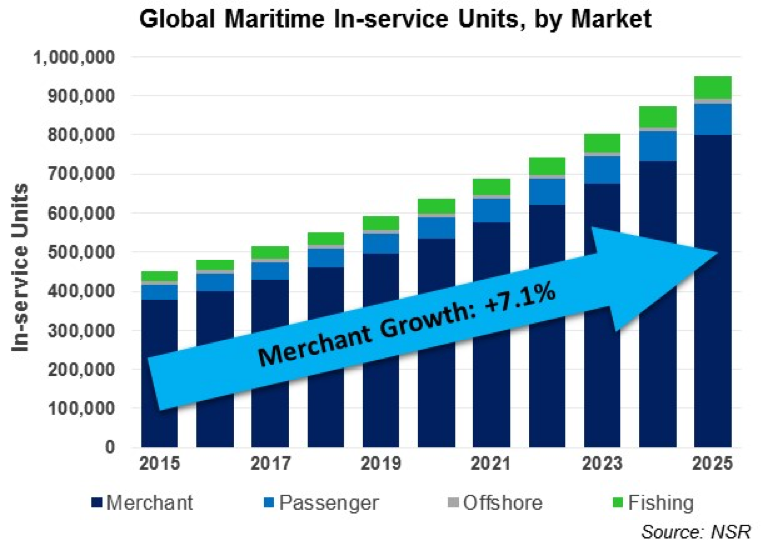Finding
Satcom Value in Shipping
Sep
19th, 2016 by
Dallas Kasaboski NSR
Digital
Ship’s Connectivity Briefing recently
held at the SMM in Hamburg explored the
potential of greater data demand in the
maritime industry. The
NSR-moderated panel, entitled,
“Innovation and Evolution and the
Integration of Maritime Applications”,
focused on crew and operational
applications, and developments in big
data and IoT related traffic. Market
oversupply of HTS capacity has recently
led service providers to push higher
data plans, with built-in applications
promoted as “the next big thing”.
However, as was made clear during the
panel,
merchant
maritime end-users are not interested in
more data, but on cutting costs
on their service and their operations.
NSR’s Maritime Market Report, 4th
Edition, forecasts that of the $2.7
billion retail revenue potential in the
merchant segment by 2025, only 14% will
come from HTS service.
Narrowband
will continue to dominate the market
segment,
and even cheaper capacity is not
favoring a significant shift in VSAT
technology adoption.
There is a disparity between the
needs of merchant maritime end-users and
the increasing supply of capacity and
applications available on the market.
Service providers looking to corner
larger pieces of the pie will need to
address the following issues going
forward.
HTS vs. FSS
As opposed
to many in the satellite industry,
maritime players do not seem concerned
with the contest between HTS and FSS.
Ship owners
simply want something that works,
period. Where and when they need it, at
an affordable price are key drivers and
for service providers, they want that
process to be as easy as possible to
ensure “sticky customers”.
For them, networks are not an
“either/or” between FSS and HTS,
but
rather a combination.
In order to reach more customers, and
handle the wide range of needs between a
merchant ship and a passenger vessel,
they have built “capacity ecosystems”,
VSAT networks that use both FSS and HTS
capacity. In the end, users should not
be concerned with the type of capacity,
and it is the job of the service
provider to seamlessly switch between
beams when the ship’s location or needs
demand it.
“Smart Data, not Big Data”
Despite
announcements for HTS and services,
merchant maritime users seem content
with the amount of data they currently
have access to.
While crew welfare applications are
viewed as important for fleet operations,
and these applications generally come
with a higher data demand, the priority
in merchant shipping is not in streaming
media, but in calling loved ones.
Crew
calling, email, VoIP are driving crew
data demand,
and they do not represent a
significantly greater increase in data
usage.
Services involving M2M and IoT are
viewed skeptically.
Applications of this type have existed
for some time, and
unless the
application can be easily proven to save
the fleet owner money,
there is little incentive to adopt it.
Before end-users outfit their ships with
more sensors and applications to analyze
and predict problems onboard, end-users
demand focus in making it easier for
fleet managers to work with many ships
who have different sensors, different
types of data, and different network
capacity.
Who Manages the Applications?
Service
providers have begun moving down the
value chain, offering unique value-added
services in an attempt to increase
revenues and differentiate themselves in
the market. Applications for network
configuration, telemedicine and
e-Learning are just some of the revenue
and capacity opportunities service
providers are using to “monetize the
bytes”.
However, there is a
growing
divide between some end-users and
service providers.
Many fleet operators would rather a
third party, more in tune with maritime
needs and concerns, create and manage
the applications, while service
providers feel best-suited to manage
applications on their network.
Issues such as cyber-security, legal
concerns, proprietary knowledge and
specific fleet operation all must be
understood and handled appropriately,
and there is strong reluctance from the
end-user to accept that service
providers can manage their applications
accordingly.
The Bottom Line
An
analysis of merchant vessels reveals
data
demand and satcom spending are among the
lowest in maritime,
a trend which is expected to continue
unless service providers can find ways
to close the gap by offering more value
and incentives for adopting broadband
services.

Merchant maritime fleets tend not to
change unless regulation or finances
demand it. While cheaper capacity has
spurred some VSAT adoption,
shipping fleets seem content to keep
things as they are.
The fleet manager’s primary need when
choosing a satcom service is to cut
costs, through paying less for the
service, improving the operational
efficiency of their fleet, or preferably
a combination of the two. Since cutting
costs is so important to fleet
operators,
the only way
to make merchant spending go up is not
by adding data, but by adding value.
In a
sector that has seen huge losses,
valuable applications such as container
tracking, reefer management, and fuel
optimization may be the way forward
both for service providers and fleet
owners. These applications have to be
easy to adopt, comply with all the
necessary regulations, be compatible
with current ship operations, and
demonstrate clear cost savings.
The Connectivity Briefing was a
valuable experience, offering refreshing
perspectives of the maritime satcom
value chain from some of the key players
involved. The concerns expressed by
merchant end-users are not new, but this
panel provided an opportunity to bring
them into the spotlight and help drive
the conversation, and service offerings,
going forward. There is still work to be
done on the “integration” of merchant
maritime applications, namely that
service providers need to focus on
applications which improve fleet
efficiency, and turn operational savings
into spending on satcom. Whether these
applications should be managed by
service providers, end-users, or third
parties is still up for debate, but the
conversation should continue in order
for merchant fleets and service
providers to get the most out of
maritime satcom services.